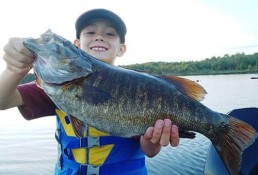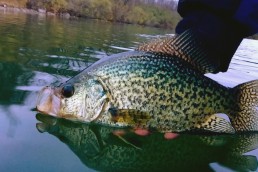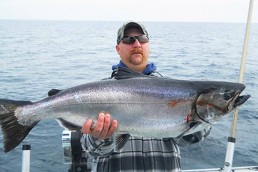What’s up…North
SHARE THIS POST
Tackling Summer Smallmouth
Compared to the last couple of years, our move from hard water to pre-summer seemed to happen in an instant up north. We have gone from having ice floating around on the lakes the past couple of openers, to 60-degree water temps for the opener on those very same lakes. Gotta love Northern Minnesota weather.
Although early warming trends and the early ice out make for a difficult opening walleye bite for most, it sets things up for some awesome bass fishing, and in this neck of the woods, that means smallmouth. Let’s discuss what you need to have in the boat for chasing early summer smallies, without filling the boat with what you don’t need.
Summer smallmouth bass fishing can be simplistically easy, or a lesson in frustration. One of the keys to success is versatility, but this doesn’t mean you need a truckload of baits with you. Search baits are always a good place to start when you begin your day. By search bait, I mean something that you can fish fairly quickly and cover water with to figure out what the fish are doing on that day.
Some of my favorites for this are suspending jerkbaits like the new Rapala Shadow Rap or X-Rap, walking top-waters, like the Rapala Skitterwalk, soft plastic swim baits, like Berkely’s Ripple Shad and Split Belly, and shallow running crankbaits that run in the 5- to 10-foot range. The Storm Wigglewart and Rapala DT6s and DT10s are standbys here, with the new Scatter Rap series quickly becoming another favorite. Many shallow to medium diving cranks work here if you have a different favorite. Lastly don’t forget a couple of your favorite spinnerbaits.
This may seem like a lot of baits to choose from, but each has its purpose, and the type of structure and cover you’re dealt will dictate what to throw. The jerkbait is a great starting point, especially when fish are holding off the first breaks of spawning flats—a likely scenario right now. Lean toward the more subtle action cold-water jerks like the Shadow Rap if the water is cooler or in post-frontal scenarios, and the wider side to side more aggressive action baits like the X-Rap in warmer water and low pressure. The cranks are for searching for fish that are feeding or roaming up on the flats. The wart is tough to beat in cooler water and post-frontal conditions. Opt for one of the Scatter Raps or DTs in warmer water. Make your ultimate decision on depth, as you want these baits contacting bottom.
Are you enjoying this post?
You can be among the first to get the latest info on where to go, what to use and how to use it!
The swimbait comes into play when you’re faced with submerged vegetation that becomes too thick to fish a hardbait through. Throw a four- to five-inch bait here. You want a profile that they can find in the weeds, also remembering that we are in “search mode.” We’re not trying to catch every fish in the lake right now; we’re covering water and learning what the bass are doing. Smallies will follow that swimbait in a lot, and plenty will eat it as well. Trust me, a two-pound smallmouth has no problem inhaling a five-inch swimbait if he wants it. The walking bait is always within reach because, well, because who in their right mind would go smallie fishing without at least one top-water tied on?
Truthfully any top-water would work here, but the walking bait is just more efficient for covering water. Sometimes smallmouth have a preference for a certain type of top-water, and sometimes they don’t care as long as it is a top-water, often refusing anything that’s sub-surface. The point is, make sure you keep a top-water wet.
Lastly, the lowly, old school, often forgotten spinnerbait. When the wind is blowing 20-plus-mph, and you can’t even feel the jerkbait at the end of your line due to the huge bow it has, pick up that spinnerbait. Not only will it make boat control and fishing in a miserable wind tolerable, you might just catch your biggest smallie of the year on it. Don’t go too small here. You want at least a 1/2-ounce bait with a couple big blades on it.
When things go as planned, the aforementioned baits will be all you need for successful summer smallie fishing. But if you’ve spent a fair amount of time smallmouth bass fishing, you know that sometimes they just turn into little brown devils, often for no apparent reason. Often, the previously mentioned baits fished slowly will get you plenty of fish, but if you get some extremely tough conditions thrown at you, bring these three day-savers, along with your favorite spinning rod. First, a three- to four-inch grub, which might be the most versatile of all smallie baits. With a selection of jigheads, you can swim, drag, or hop it, in any cover, at any depth, fast or slow. Next, a three- to four-inch tube, arguably slightly less versatile than the grub, but providing a spiraling action that often will open a lock-jawed smallie’s mouth. Lastly, bring some four-inch soft plastic stickbaits of your choice. These can be slowly worked through the heaviest cover when Texas rigged, wacky rigged in sparse cover, or fished on a drop shot either way, at any depth. Additionally, any of these three baits can be fished back through an area where you have located fish while in “search mode,” often garnering a few extra bites.
Remaining versatile, and choosing baits based on the cover and structure in front of you, will help make this summer’s smallmouth bass fishing successful.
MWO
SHARE THIS POST
Did you enjoy this post?
You can be among the first to get the latest info on where to go, what to use and how to use it!
Scott Walsh
MidWest Outdoors works with more than 200 outdoor experts each year, who contribute articles based on their areas of expertise. MidWest Outdoors magazine offers more fishing and hunting articles than any other publication!



